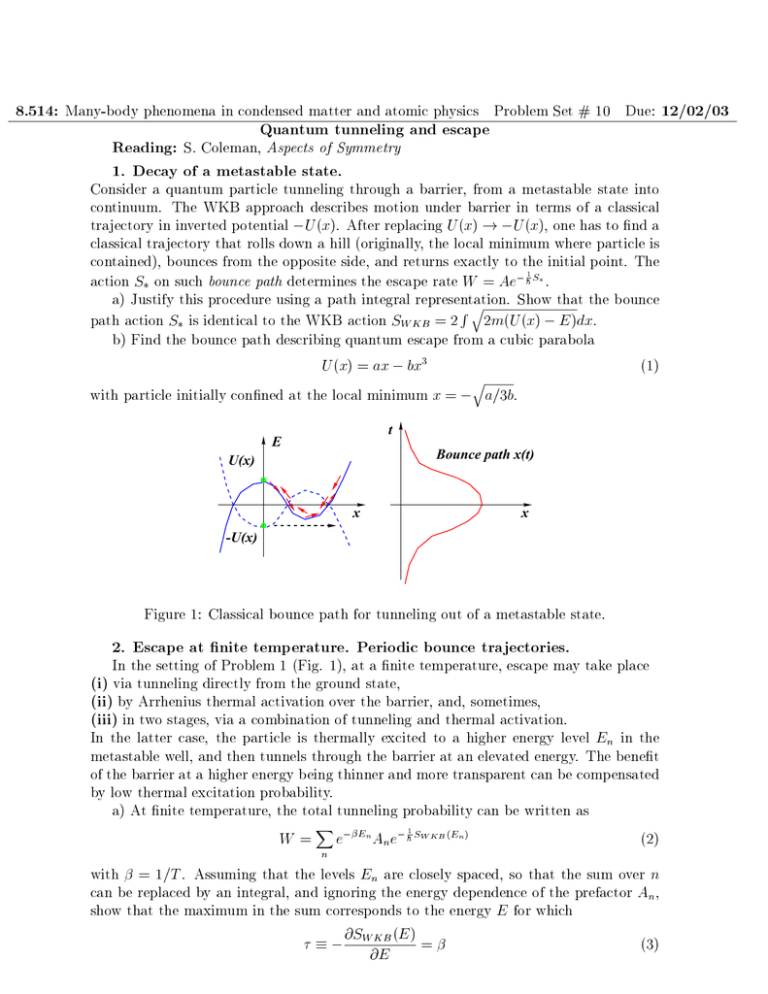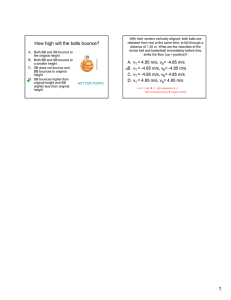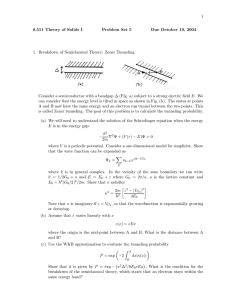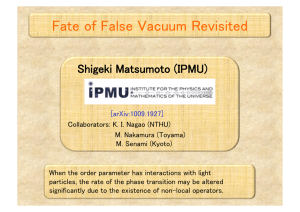8.514: 12/02/03 Quantum tunneling
advertisement

8.514: Many-body phenomena in condensed matter and atomic physics Problem Set # 10 Due: 12/02/03 Quantum tunneling and escape Reading: S. Coleman, Aspects of Symmetry 1. Decay of a metastable state. Consider a quantum particle tunneling through a barrier, from a metastable state into continuum. The WKB approach describes motion under barrier in terms of a classical trajectory in inverted potential ;U (x). After replacing U (x) ! ;U (x), one has to nd a classical trajectory that rolls down a hill (originally, the local minimum where particle is contained), bounces from the opposite side, and returns exactly to the initial point. The ; h�1 S� action S� on such bounce path determines the escape rate W = Ae . a) Justify this procedure using a path integral representation. Show that the bounce Rq path action S� is identical to the WKB action SW KB = 2 2m(U (x) ; E )dx. b) Find the bounce path describing quantum escape from a cubic parabola (1) U (x) = ax ; bx3 q with particle initially conned at the local minimum x = ; a=3b. t E Bounce path x(t) U(x) x x -U(x) Figure 1: Classical bounce path for tunneling out of a metastable state. 2. Escape at nite temperature. Periodic bounce trajectories. In the setting of Problem 1 (Fig. 1), at a nite temperature, escape may take place (i) via tunneling directly from the ground state, (ii) by Arrhenius thermal activation over the barrier, and, sometimes, (iii) in two stages, via a combination of tunneling and thermal activation. In the latter case, the particle is thermally excited to a higher energy level En in the metastable well, and then tunnels through the barrier at an elevated energy. The benet of the barrier at a higher energy being thinner and more transparent can be compensated by low thermal excitation probability. a) At nite temperature, the total tunneling probability can be written as X W = e; En Ane; h�1 SW KB (En) (2) n with = 1=T . Assuming that the levels En are closely spaced, so that the sum over n can be replaced by an integral, and ignoring the energy dependence of the prefactor An, show that the maximum in the sum corresponds to the energy E for which KB (E ) � ; @SW@E = (3) Note that the quantity has a meaning of the classical travel time. Thus at a nite temperature the bounce paths that give the leading contribution to the escape rate are periodic functions of the imaginary time, x(t + ) = x(t). b) Discuss the temperature dependence of the escape rate for the cubic parabola (1). Start at high temperature (small ), and show that in this case the saddle point trajectory is constant, x(t) = xmax , where xmax is the barrier top coordinate. Find the critical c at which the constant solution becomes unstable and turns into an oscillatory solution. Make a schematic plot of ln W vs. , identify the Arrhenius and the tunneling regimes. 3. Decay of supercurrent in a Josephson junction. Consider a Josephson junction shunted by an Ohmic resistor and biased by an external current I . The imaginary time action for this problem is m _2 + U () ; I dt + ZZ ((t) ; (t0 ))2 dt dt0 (4) 2 4 (t ; t0 )2 with U () = Jc(1 ; cos ). a) Write down the saddle-point equation S= = 0. By comparing with the classical equations of motion, CV_ + R;1V + Jc sin = I , 2eV = h _ nd the relation between m and and the junction capacitance and resistance. b) Classically, the supercurrent can ow as long as the eective potential U () ; I has a local minimum. (For a stationary solution of Jc sin = I , since _ = 0, there is no voltage, and hence no dissipation.) This requires the external current to be in the range ;Jc < I < Jc. In such a case, the decay of supercurrent is controlled by quantum and thermal uctuations. The decay is described by the system (4) tunneling out a local minimum of U () ; I. To determine the decay rate, one has to nd a classical bounce trajectory in imaginary time, as it was done in problem 1 in the absence of dissipation, = 0. How are these results modied for tunneling in a dissipative system? Caldeira and Leggett pointed out that the bounce solution can be constructed in an analytic form for the highly overdamped regime, � m= , where is the time of tunneling (3). In this case, by a dimensional estimate, one shows that the kinetic energy term m_2 =2 is small compared to the dissipative term and thus can be dropped. Further simplication can be achieved near the classical stability threshold, where the eective potential can be replaced by a cubic parabola (1) with a = Jc ; I , b = 16 Jc, x = ; 0 . Show that in the overdamped regime, the saddle point equation S= = 0 can be satised by a Lorentz function ansatz (t) = 0 + t2 +A 2 (5) Find A and and evaluate the action. Compare with the result found above for = 0. c) Consider the decay of an overdamped Josephson junction at a nite temperature. Estimate the temperature above which the T = 0 solution found in part b) is substantially modied. Describe the crossover from the tunneling to the Arrhenius regime in terms of the dependence ln W vs. . S= Z






